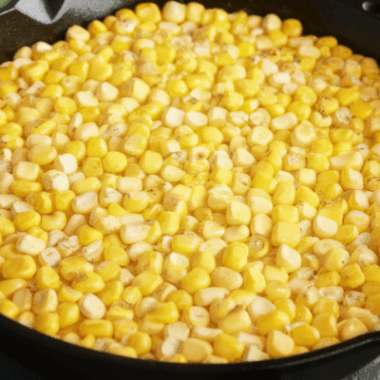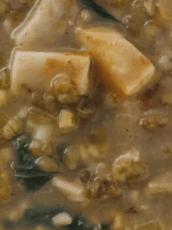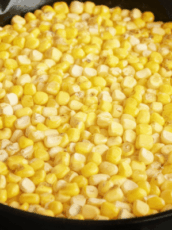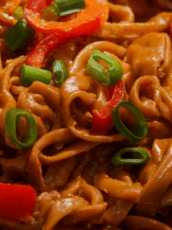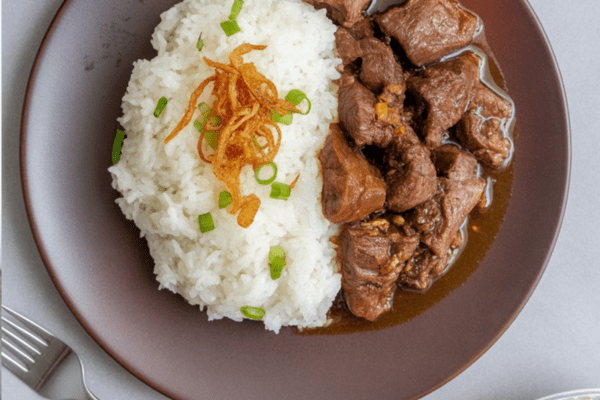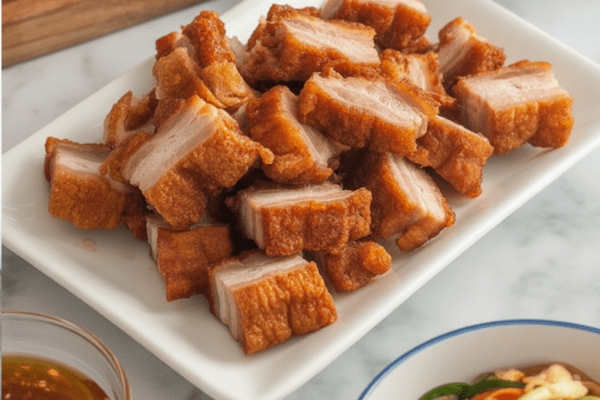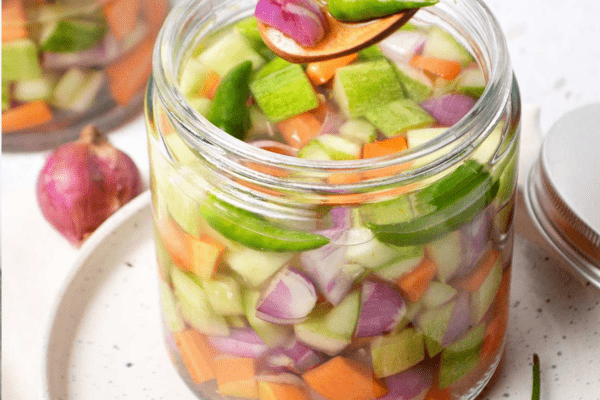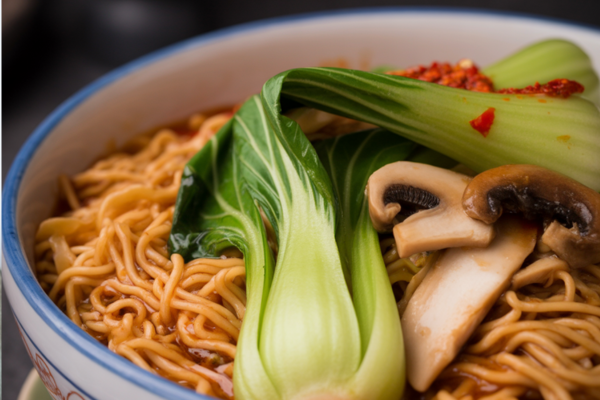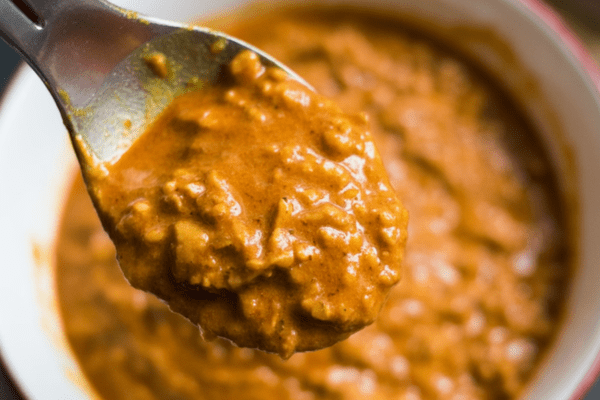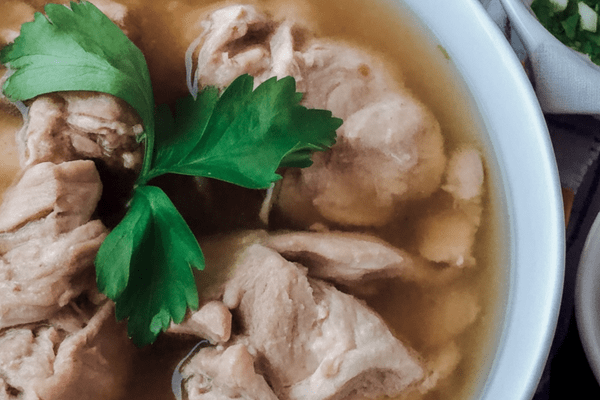There’s something deeply comforting about a big pot of munggo simmering on the stove. This version, cooked with coconut milk and tender pork, is the kind of dish that reminds me of home—warm, filling, and always best with a scoop of rice. It’s one of those recipes you make when you want a simple, honest meal that still feels a bit special thanks to the creamy richness of coconut milk.
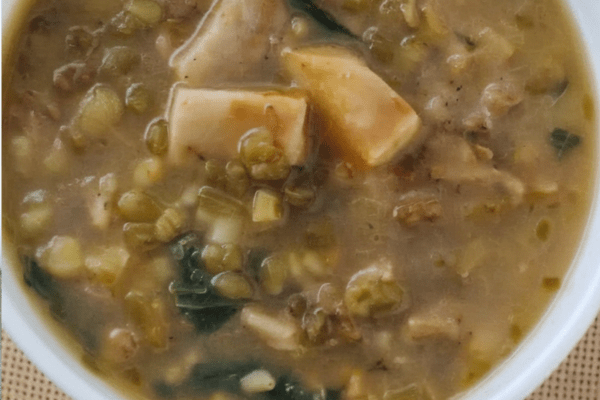
I love mung beans because they’re so reliable. Affordable, full of nutrients, and they stretch to feed a crowd. On busy days, I’ll often cook a batch and keep it in the fridge, ready for stews like this or even sweet ginataang munggo for merienda.
Getting the Beans Ready
Whenever I use mung beans, I like to give them a quick check on the counter first. I pour them out onto a tray to spot any old or shriveled ones—they don’t cook evenly and can ruin that soft, creamy texture.
After picking through them, I rinse them thoroughly under cold running water. I find this helps get rid of any dusty residue and also seems to freshen them up.
I don’t usually bother soaking mung beans overnight for this recipe. With a gentle simmer, they soften beautifully in about an hour—perfect for a lazy afternoon of cooking when you have time to let it bubble on the stove while you prep other dishes.
My Best Tips for Cooking It Right
One thing I’ve learned making this dish over and over is to wait before adding the tomatoes. Adding them too early can toughen the beans—so I always cook the mung beans first until they’re tender, then stir in the tomatoes later so everything stays nice and soft.
If you’re the type who loves a bit of heat in your food (I do, especially on rainy days), try adding a spoonful of curry powder. It gives the dish a subtle kick and a lovely warmth that pairs really well with the coconut milk.
And if you want that really thick, almost dal-like consistency? I sometimes take a portion of the cooked mung beans and mash them with a ladle right in the pot. It makes the whole stew creamier without adding anything extra.
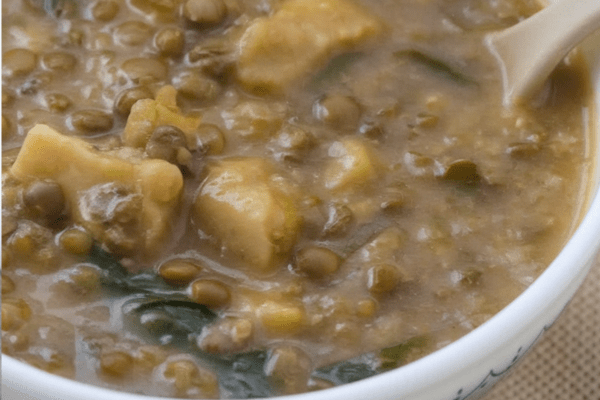
Serving Ideas from My Table
I think this stew is best served simply, with steaming hot rice on the side. That way, you can really soak up all that coconut-rich sauce.
In my house, we often serve it with fried fish or even leftover grilled chicken. The mild, creamy flavor of the munggo balances salty or smoky dishes beautifully.
If I’m cooking for a big family lunch, I’ll set it out buffet-style with rice, fried tilapia, and some fresh tomatoes with onions for a quick salad. It’s an easy way to feed everyone without fuss.

Keeping It for Later
This dish holds up well for leftovers, which is one of my favorite things about it. I usually pack it into containers once it cools down, then refrigerate it for up to three days.
If you’re planning to freeze it, let it cool completely first. I’ve kept frozen portions for a couple of months. When reheating, I like to do it gently on the stove over medium heat, adding a splash of water or broth to loosen it if it’s too thick. I’ll usually taste and add a dash of fish sauce or a pinch of salt before serving to freshen up the flavor.
Pork Monggo Recipe

A comforting Filipino classic, this mung bean stew simmered in creamy coconut milk is both hearty and economical.
Ingredients
- 1 ½ cups coconut milk
- ½ pound pork belly or pork shoulder, diced
- 1 large ripe tomato, chopped
- 1 tablespoon fish sauce
- 1 cup dry mung beans
- 6 cups water
- 1 tablespoon cooking oil
- 2 cloves garlic, minced
- 1 onion, thinly sliced
- 1 bunch fresh spinach, tough stems removed
- Salt and black pepper, to taste
Instructions
- Prep the Mung Beans: Begin by sorting through the mung beans to remove any unwanted bits or damaged pieces. Rinse thoroughly under cold water until the liquid runs clear. Drain and set aside.
- Cook the Beans: In a large pot, combine mung beans and water. Bring to a boil over medium heat, skimming off any foam that surfaces. Lower the heat, cover the pot, and let the beans simmer for about 45–50 minutes or until they’re tender and the skins have split. Check occasionally and add water if needed to keep the liquid level at about 4 cups.
- Sauté the Aromatics and Pork: In a separate deep pan or pot, heat the oil over medium heat. Sauté the garlic and onions until they soften and release their aroma. Toss in the diced pork and cook until the meat is lightly browned.
- Build the Flavor Base: Stir in the chopped tomatoes, pressing them with your spoon until they break down and release their juices. Add the fish sauce and let everything cook together for another 2 minutes to meld the flavors.
- Combine and Simmer: Pour the cooked mung beans along with their cooking liquid into the pork mixture. Let it come to a gentle boil. Continue to simmer until the pork is fork-tender and the broth slightly thickens, about 10–15 minutes.
- Add Coconut Milk: Stir in the coconut milk and reduce the heat to low. Let it gently simmer for 3–5 minutes, allowing the stew to become rich and creamy. Season with salt and pepper to taste.
- Finish with Greens: Just before serving, add the spinach. Turn off the heat and cover the pot, letting the residual warmth wilt the greens for 1–2 minutes.
Notes
- For a thicker soup, gently mash some of the mung beans or blend a small portion before adding the coconut milk.
- Want to spice it up? Add a few slices of chili during the final simmer.
- Substitute malunggay (moringa leaves) or kale if spinach isn't available.
Nutrition Information:
Yield: 6 Serving Size: 1Amount Per Serving: Calories: 372Total Fat: 28gSaturated Fat: 16gTrans Fat: 0gUnsaturated Fat: 10gCholesterol: 52mgSodium: 448mgCarbohydrates: 14gFiber: 5gSugar: 3gProtein: 20g
Asianplated.com, occasionally offers nutritional information for recipes contained on this site. This information is provided as a courtesy and is an estimate only. This information comes from online calculators. Although allchickenrecipes.com attempts to provide accurate nutritional information, these figures are only estimates.
An Idea to Try
If you want to mix it up, you can swap the pork for smoked fish like tinapa. It gives the stew a lovely, deep smoky flavor that really stands out against the creaminess of the coconut milk. Just flake the fish and stir it in near the end so it doesn’t fall apart too much.
Try other Filipino recipes:

